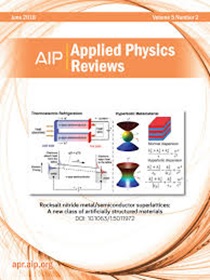All-optical modulation self-powered optoelectronic synaptic devices with monochromatic ultraviolet for inhibitory/excitatory synaptic behaviors
IF 11.6
1区 物理与天体物理
Q1 PHYSICS, APPLIED
引用次数: 0
Abstract
Self-powered optoelectronic synaptic devices play an important role for the construction of neuromorphic computing systems. Nevertheless, these devices can only simulate optically excitatory synaptic behaviors, while mimicking optically inhibitory functions remains a challenge, arising from the photo-generated carriers that usually lead to the enhancement of conductivity in these devices. This limitation hinders the application development of the self-powered optoelectronic synaptic devices in neuromorphic computing. In this work, a self-powered optoelectronic synaptic device based on the tin dioxide and cesium silver bismuth bromide heterojunction is developed. Through utilizing the ion migration and photo-generated carrier transport behaviors in the heterojunction, self-powered optically inhibitory and excitatory synaptic behaviors are successfully mimicked under ultraviolet (365 nm) monochromatic all-optical modulation. On this basis, a convolutional neural network has been constructed with the software-based means to recognize images (the absence of real hardware-level image processing) in fashion MNIST dataset and an accuracy of 84.48% is obtained in this network, indicating broad application prospects of the all-optical self-powered systems in the neuromorphic computing.单色紫外全光调制自供电光电突触装置用于抑制/兴奋突触行为
自供电光电突触装置在构建神经形态计算系统中起着重要作用。然而,这些器件只能模拟光兴奋性突触行为,而模拟光抑制功能仍然是一个挑战,因为这些器件中的光生成载流子通常会导致电导率增强。这一限制阻碍了自供电光电突触器件在神经形态计算中的应用发展。本文研制了一种基于二氧化锡和溴化铯银铋异质结的自供电光电突触器件。利用离子迁移和光产生的载流子在异质结中的输运行为,成功地模拟了紫外光(365 nm)单色全光调制下自供电的光抑制和兴奋突触行为。在此基础上,利用基于软件的方法构建卷积神经网络,对时尚MNIST数据集进行图像识别(缺少真正的硬件级图像处理),准确率达到84.48%,显示了全光自供电系统在神经形态计算中的广阔应用前景。
本文章由计算机程序翻译,如有差异,请以英文原文为准。
求助全文
约1分钟内获得全文
求助全文
来源期刊

Applied physics reviews
PHYSICS, APPLIED-
CiteScore
22.50
自引率
2.00%
发文量
113
审稿时长
2 months
期刊介绍:
Applied Physics Reviews (APR) is a journal featuring articles on critical topics in experimental or theoretical research in applied physics and applications of physics to other scientific and engineering branches. The publication includes two main types of articles:
Original Research: These articles report on high-quality, novel research studies that are of significant interest to the applied physics community.
Reviews: Review articles in APR can either be authoritative and comprehensive assessments of established areas of applied physics or short, timely reviews of recent advances in established fields or emerging areas of applied physics.
 求助内容:
求助内容: 应助结果提醒方式:
应助结果提醒方式:


